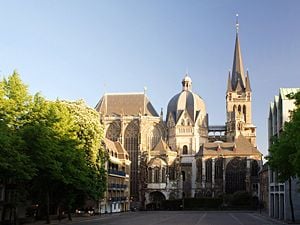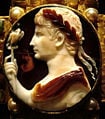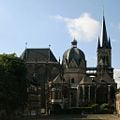Difference between revisions of "Aachen Cathedral" - New World Encyclopedia
David Doose (talk | contribs) m (→History) |
David Doose (talk | contribs) m (→History) |
||
| Line 23: | Line 23: | ||
Charlemagne collected a variety of relics during his lifetime, which are still kept in the Aachen Cathedral. The four most important are: | Charlemagne collected a variety of relics during his lifetime, which are still kept in the Aachen Cathedral. The four most important are: | ||
<blockquote> | <blockquote> | ||
| − | + | The cloak of the Blessed Virgin; | |
| − | + | The swaddling-clothes of the Infant Jesus; | |
| − | + | The loin-cloth worn by Christ on the Cross; and | |
| − | + | The cloth on which lay the head of St. John the Baptist after his beheading. | |
</blockquote> | </blockquote> | ||
Revision as of 23:07, 13 April 2009
| Aachen Cathedral* | |
|---|---|
| UNESCO World Heritage Site | |

| |
| State Party | |
| Type | Cultural |
| Criteria | i, ii, iv, vi |
| Reference | 3 |
| Region** | Europe and North America |
| Inscription history | |
| Inscription | 1978 (2nd Session) |
| * Name as inscribed on World Heritage List. ** Region as classified by UNESCO. | |
Aachen Cathedral, frequently referred to as the "Imperial Cathedral" (in German: Kaiserdom) is a Roman Catholic church in Aachen, Germany. The church is the oldest cathedral in northern Europe and was known as the "Royal Church of St. Mary at Aachen" during the Middle Ages. For 600 years, from 936 to 1531, the Aachen chapel was the church of coronation for 30 German kings and 12 queens.
The Cathedral of Aachen is one of the most famous examples of occidental architecture. It is the burial site of Charlemagne and a major pilgrimage site. The church has been the episcopal seat of the Diocese of Aachen since 1930. In 1978 it was the first German building to be included in the UNESCO World Heritage list.
History
Charlemagne (Karl der Grosse in German), the first Holy Roman Emperor, began building his Palatine Chapel (palace chapel) in 786 C.E. The Palatine Chapel has been described as a "masterpiece of Carolingian architecture". It is all that remains today of Charlemagne's extensive palace complex in Aachen.
The Palatine Chapel was designed by Odo of Metz. He based it on the Byzantine church of San Vitale (completed 547 C.E.) in Ravenna, Italy. This accounts for the very eastern feel to the chapel, with its octagonal shape, striped arches, marble floor, golden mosaics, and ambulatory. It was consecrated in 805 to serve as the imperial church.
Charlemagne collected a variety of relics during his lifetime, which are still kept in the Aachen Cathedral. The four most important are:
The cloak of the Blessed Virgin; The swaddling-clothes of the Infant Jesus; The loin-cloth worn by Christ on the Cross; and The cloth on which lay the head of St. John the Baptist after his beheading.
In the Middle Ages, these relics attracted swarms of pilgrims from Germany, Austria, Hungary, England, Sweden, and other countries. In the mid-14th century, it became customary to show the four "Great Relics" only once every seven years, a custom which continues today (the the last was in 2007).
Symbolism of Octagon
The construction of Aachen Cathedral features an octagonal dome 32 meters high. Charlemagne's tomb is in the Cathedral altar. It is adorned with engravings of the King and Pope Leo the Third. Pope Leo crowned Charlemagne as the Imperator Romanorum, Emperor of the Romans, in the year 800.
The great dome above the altar is octagonal because Charlemagne placed special significance on the number "eight". The numeral appears frequently in the Holy [[Bible] and was charged with symbolism in the Christian world during medieval times. An octagon can be made by drawing two intersecting squares within a circle. The circle represents God's eternity while the square represents the secular world. The four corners also represent the four directions to heaven and the four characteristics of man. Charlemagne saw the number eight as symbolizing the power of the Franks and the Roman Empire, the ruler of both the secular and religious worlds. The Franks were later to become known as the Holy Roman Empire. The Emperor's throne –built in the 10th century – overlooks the altar. The two relics in his hands were symbols of his power as ruler of two worlds. Charlemagne is holding a sceptre symbolizing his rule of the secular world in his right hand, while in his left he holds an orb, the symbol of the religious world.[1]
Treasury
The Aachen cathedral treasury displays sacral masterpieces of the late Classical, Carolingian, Ottonian and Staufian period - among them there are some unique exhibits like the "Cross of Lothair" the "Bust of Charlemagne" and the "Persephone sarcophagus." The Cathedral Treasury in Aachen is regarded as one of the most important ecclesiastical treasuries in northern Europe.
Final Resting Place of Charlemagne
When he died in 814, Charlemagne was buried in a vault in the cathedral.
In 1000, Otto III had Charlemagne's vault opened. Otto of Lomello, one of the courtiers who accompanied him, recorded the event, which is reported in the Chronicle of Novalesia, written about 1026. The account reads:
So we went in to Charles. He did not lie, as the dead otherwise do, but sat as if he were living. He was crowned with a golden crown and held in his gloved hands a sceptre; the fingernails had penetrated through the gloves and stuck out. Above him was a canopy of limestone and marble. Entering, we broke through this. Upon our entrance, a strong smell struck us. Kneeling, we gave Emperor Charles our homage, and put in order the damage that had been done. Emperor Charles had not lost any of his members to decay, except only the tip of his nose. Emperor Otto replaced this with gold, took a tooth from Charles’s mouth, walled up the entrance to the chamber, and withdrew again.[2]
A large picture representing Otto and his nobles gazing on the dead Emperor was painted on the wall of the great room in the Town Hall.
In 1165, Emperor Frederick Barbarossa again opened the vault and placed the remains in a sculptured sarcophagus made of Parian marble, said to have been the one in which Augustus Caesar was buried. The bones lay in this until 1215, when Frederick II had them put in a casket of gold and silver. A vellum codex found interred with him was removed.
Shrine of the Virgin Mary
The Shrine of St. Mary rests in the choir of the church and dates from 1220-1239. Adorned with the figures of Christ, Mary, Charlemagne, Pope Leo III and the Twelve Apostles, the shrine contains the four great Aachen relics: St. Mary's cloak, Christ's swaddling clothes, St. John the Baptist's beheading cloth and Christ's loincloth. Following a custom begun in 1349, every seven years the relics are taken out of the shrine and put on display during the Great Aachen Pilgrimage. This pilgrimage most recently took place during June 2007.
Other burials
- Otto III, Holy Roman Emperor
Gallery
- AachenCathedral hb.JPG
Cathedral exterior
Throne of Charlemagne
Sarcophagus of Charlemagne
Reliquary bust of Charlemagne
Shrine of the Virgin Mary (1238)
- AachenerDomApsis.jpg
Stained glass windows (1414)
Notes
- ↑ The Mystery of the Octagon: Aachen Cathedral Portal.unesco.org. Retrieved April 13, 2009.
- ↑ Monumenta Germaniae Historica, Scriptores, VII, book III, 32.
ReferencesISBN links support NWE through referral fees
- Carl, Alfred, Nikolas Funke, and Nina Neckenbürger. 2002. Aachen and Its Cathedral: Notes on the City and a Guide to its Centre. Aachen: Einhard. ISBN 3936342059
- Dickmann, Ines, Michael Imhof, and Richard Lindsay. 2005. Aachen City and Cathedral Guide. Petersberg: Imhof. ISBN 9783865680266
- Schmitz-Cliever-Lepie, Herta, Ann Münchow, Erich Stephany, Leo Hugot, Carole Steber, and Susanne Steber-Jacobs. 1986. The Treasury of the Cathedral of Aachen. Aachen (Germany): Chapter of the Cathedral. OCLC 38735496
- Stephany, Erich. 1989. Aachen Cathedral. S.l: s.n.]. OCLC 39666994
- World Heritage: Monumental Sites. 2003. Milano: Skira. ISBN 9231039199
External links
- Aachen Cathedral (Kaiserdom)
- Aachen Cathedral Guide
- World Heritage Site
- Aachen Cathedral website (in German)
- Cathedral Music
| |||||||
Coordinates:
Credits
New World Encyclopedia writers and editors rewrote and completed the Wikipedia article in accordance with New World Encyclopedia standards. This article abides by terms of the Creative Commons CC-by-sa 3.0 License (CC-by-sa), which may be used and disseminated with proper attribution. Credit is due under the terms of this license that can reference both the New World Encyclopedia contributors and the selfless volunteer contributors of the Wikimedia Foundation. To cite this article click here for a list of acceptable citing formats.The history of earlier contributions by wikipedians is accessible to researchers here:
The history of this article since it was imported to New World Encyclopedia:
Note: Some restrictions may apply to use of individual images which are separately licensed.











